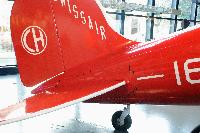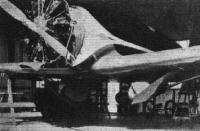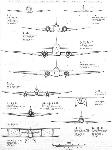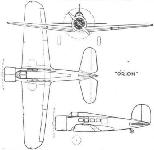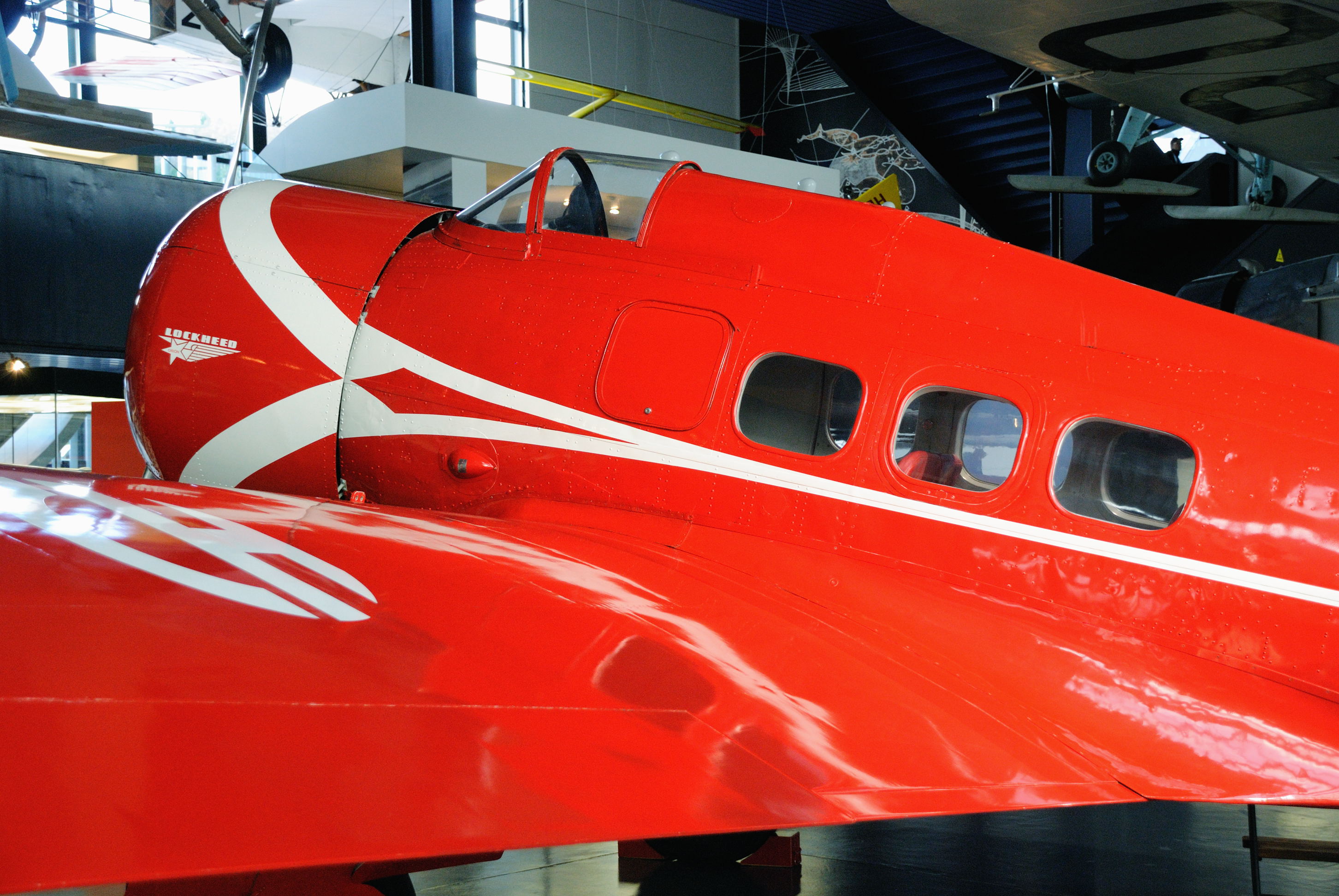
Lockheed 9 Orion
В конце 1930 года на основе анализа потенциального рынка легких пассажирских самолетов компания "Lockheed" приступила к проектированию Lockheed 9 Orion на шесть пассажиров. Самолет представлял собой комбинацию фюзеляжа от Vega с низкорасположенным крылом, шасси от Lockheed Altair и капотом типа NACA, как у Air Express. Первый Orion поднялся в воздух в начале 1931 года. Всего было построено 35 машин, в Orion также конвертирован один Altair DL-2A.
Первый Orion поступил в компанию "Bowen Air Lines" (Форт-Уорт, штат Техас) в мае 1931 года. Самолеты Orion летали еще в 12 авиакомпаниях США. Правительство Испанской республики в 1936 году купило не менее 13 самолетов у разных владельцев для своих ВВС, они принимали участие в гражданской войне.
Варианты
Orion 9: исходный серийный вариант с 410-сильным мотором Pratt & Whitney Wasp A или 420-сильным Wasp C; построено 14
Orion 9A Special: один самолет с мотором Wasp SC мощностью 450 л.с. и несколько измененным фюзеляжем
Orion 9B: два самолета с мотором Wright R-1820-E Cyclone мощностью 575 л.с.; поставлены Швейцарии
Orion 9C: один модернизированный Altair DL-2A
Orion 9D: серийный вариант с доработанным фюзеляжем, изначально оснащался мотором Wasp S1D1; построено 13
Orion 9E: три самолета, близкие к исходному Orion 9, но с мотором Wasp SC1 мощностью 450 л. с.
Orion 9F: один самолет повышенной комфортабельности с мотором Wright R-1820-F2 Cyclone мощностью 645 л. с.
Orion 9F-1: один самолет повышенной комфортабельности с мотором Wright SR-1820-F2 Cyclone мощностью 650 л. с.
UC-85: обозначение одного Orion 9D, закупленного в июне 1942 года ВВС Армии США
Orion-Explorer: обозначение Orion 9E с замененным после аварии крылом, неубираемым шасси и мотором Wasp S3H1 мощностью 600 л. с.; позже установлено поплавковое шасси; на самолете в таком виде предприняли попытку кругосветного перелета Вилли Пост и Билл Роджерс - 15 августа 1935 года они погибли на Аляске
ТАКТИКО-ТЕХНИЧЕСКИЕ ХАРАКТЕРИСТИКИ
Lockheed Orion 9D
Тип: легкий пассажирский самолет
Силовая установка: один звездообразный мотор Pratt & Whitney Wasp S1D1 мощностью 550 л. с. (410 кВт)
Летные характеристики: крейсерская скорость 330 км/ч; практический потолок 6705 м; дальность 1159 км
Масса: пустого 1651 кг; максимальная взлетная 2359 кг
Размеры: размах крыла 13,04 м; длина 8,64 м; высота 2,95 м; площадь крыла 27,32 м2
Описание:
- Lockheed 9 Orion
- Flight, May 1932
SPEEDING UP OF THE AIR MAIL
Фотографии
-
Мировая Авиация 174
Регистрационный номер: NC12225 [3] После закупки у компании "Lockheed" шести Lockheed 9 Orion "Varney Air Service" сменила название на "Varney Speed Lanes Air Services". Самолеты в основном доставляли почту, позже авиакомпанию еще раз переименовали - в "Continental".
-
Aeroplane Monthly 1979-02 / Lockheed Orion 9C /Preservation Profile/ (70)
Регистрационный номер: CH-167 [14], NR12222 [14] -
My photos 2010-03 / Switzerland - Luzern - Verkehrshaus der Schweiz
Регистрационный номер: CH-167 [14], NR12222 [14] -
My photos 2010-03 / Switzerland - Luzern - Verkehrshaus der Schweiz
Регистрационный номер: CH-167 [14], NR12222 [14] -
My photos 2010-03 / Switzerland - Luzern - Verkehrshaus der Schweiz
Регистрационный номер: CH-167 [14], NR12222 [14] -
Flight 1932-03 / Flight
Регистрационный номер: NC12225 [3] HIGH-SPEED AIR SERVICES: Varney Speed Lines, Ltd., operate a high-speed passenger and mail service between Los Angeles and San Francisco, a distance of 375 miles. Lockheed "Orion" monoplanes (450-h.p. Pratt & Whitney "Wasp") - one of which, "North Wind," is shown here - are used, and accomplish the journey in 1 hr. 58 min. at a speed of about 182 m.p.h.
-
Air International 1995-11 / G.Jones - Northwest is Northbest
Регистрационный номер: NC12225 [3] Lockheed Orion at Grand Central Air Terminal, Glendale, Los Angeles. Northwest added these six-passenger 178kts airliners to its fleet in 1934.
-
Aeroplane Monthly 1979-02 / Lockheed Orion 9C /Preservation Profile/ (70)
Регистрационный номер: NR12222 [14], CH-167 [14] As NR12222 Shellightning, at North Beach Airport, New York, about 1938.
-
Air International 1987-03 / R.Braybrook - The Sixties, the Thirties and the American Challenge
Регистрационный номер: NR12283 [2] The Lockheed Orion (shown) and Vultee V-1a were among the advanced single-engine low-wing designs that demonstrated the ability of the US aircraft industry to achieve good ratios of useful load to max take-off weight in the mid-thirties.
-
Flight 1938-09 / Flight
Регистрационный номер: NR12222 [14], CH-167 [14] Paul Mantz's Lockheed Orion is one of the few with a metal fuselage.
-
Aeroplane Monthly 1987-03 / D.Jones - Hollywood pilot
Регистрационный номер: NR12222 [14], CH-167 [14] Piloted by Mantz, the Orion was placed third in both the 1938 and 1939 Bendix air races.
-
Aeroplane Monthly 1987-03 / D.Jones - Hollywood pilot
Регистрационный номер: NR12222 [14], CH-167 [14] Lockheed 9C Orion NC12222, formerly Doolittle's Shellightning, became the flagship of the Mantz fleet in 1937.
-
Air International 1988-01 / Model enthusiast
Регистрационный номер: NR12222 [14], CH-167 [14] -
Aeroplane Monthly 1979-02 / Lockheed Orion 9C /Preservation Profile/ (70)
Регистрационный номер: NR12222 [14], CH-167 [14] During its subsequent civil career, as N12222.
-
Aeroplane Monthly 1979-02 / Lockheed Orion 9C /Preservation Profile/ (70)
Регистрационный номер: CH-167 [14], NR12222 [14] Up for auction in American Airlines markings, Santa Ana, May 1968.
-
Мировая Авиация 174
Регистрационный номер: NC12283 Этот NC12283 ранее использовался в "Air Express" для доставки грузов, но затем был по заказу TWA переделан в пассажирский. Самолет эксплуатировался авиакомпанией несколько лет, прежде чем его фюзеляж был использован для постройки варианта Orion-Explorer, на котором разбились Вили Пост и Билл Роджерс.
-
Flight 1932-05 / Flight
Регистрационный номер: CH-168 [2] The Lockheed "Orion" used by Swissair on its high-speed services.
-
Aeroplane Monthly 1982-10
Регистрационный номер: CH-167 [14], NR12222 [14] The beautifully finished Lockheed Orion 9C CH-167 was rebuilt in 1977, and is seen here with a Swissair DC-10. The Orion now resides in the Swiss Transport Museum at Lucerne, Switzerland.
Другие самолёты на фотографии: McDonnell Douglas DC-10 - США - 1970
-
Air Enthusiast 2001-07 / C.Justo - Ten Out of Ten
Регистрационный номер: CH-167 [14], NR12222 [14] Orion 9B CH-167, one of a pair delivered to Swissair in 1932.
-
Air International 1987-07 / Talkback
The "Lady Southern Cross” in company with a Vega and an Orion.
Другие самолёты на фотографии: Lockheed Sirius / Altair 8 - США - 1929Lockheed Vega - США - 1927
-
Aeroplane Monthly 1979-02 / Lockheed Orion 9C /Preservation Profile/ (70)
Регистрационный номер: CH-167 [14], NR12222 [14] After restoration for the Swiss Transport Museum, August 1978.
-
Flight 1932-06 / Flight
The Lockheed "Orion" of Swissair landing at Le Bourget Aerodrome
-
Flight 1932-05 / Flight
Регистрационный номер: CH-168 [2] WITH UNDERCARRIAGE RETRACTED: One of the Lockheed "Orions" of the "Swissair" company as it appears in flight.
-
Мировая Авиация 32
Регистрационный номер: NR12283 [2] Уникальный Orion-Explorer соединил в себе фюзеляж Orion и крыло недостроенного Model 7. Уили Пост и Уилл Роджерс погибли на этой машине во время кругосветного полета.
-
Мир Авиации 1995-02 / М.Маслов - Чарльз Линдберг в СССР /Перелеты/
Lockheed Orion Ч.Линдберга на Москве-реке, 25 октября 1933г.
-
Aeroplane Monthly 1983-01 / B.Gunston - The classic aero engines (5)
A Lockheed Orion with its Wasp uncowled and propless.
-
Flight 1931-05 / Flight
View showing the undercarriage operation of the "Orion"
-
Flight 1934-10 / Flight
Другие самолёты на фотографии: Airspeed Courier / AS.5 - Великобритания - 1933Airspeed Envoy / AS.6 - Великобритания - 1934Boeing Model 247 - США - 1933Douglas DC-1 / DC-2 / C-32 / C-39 - США - 1933Fairey Fairey IIIF - Великобритания - 1926Koolhoven FK-41 - Нидерланды - 1928Messerschmitt Bf.108 Taifun - Германия - 1934Miles Hawk / M.2 - Великобритания - 1932Pander S-4 Postjager - Нидерланды - 1933
-
Flight 1934-08 / Flight
"Orion" ("Wasp" S1D1).
- Фотографии




